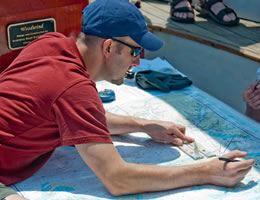
A few days have passed since we returned from our annual corporate retreat, and I’m still riding high on getting the opportunity to help crew the 74-foot Schooner Woodwind with Team Altitude. This year we chose sailing as our team-building activity. Because we’re going through an incredible period of growth and corporate evolution, we wanted an activity that would challenge us both individually and as a group—and hopefully give us a few key take-aways that would enable us to work more efficiently and effectively back at the office.
We started the process before we left by partnering with an organizational development specialist. She divided us into teams based on personality types and communication styles. The matches paired us with fellow employees we don’t typically work with, and who would challenge our individual way of doing things.
Once we got to the boat, the captain assigned each group to a role on the boat—in this case, sails, navigation and helm. Amanda Dickson and I were paired together on navigation.
After more than three glorious hours at sea, I’d have to say the experience lived up to its billing. Not only did I learn quite a bit about some of my own tendencies, strengths and weaknesses, I also learned a lot about navigating a sailboat. Sailing is a great metaphor for marketing, and I was able to draw a number of parallels.
1. Establish reliable reference points.

Amanda and I were taught how to navigate using a traditional and very analog method: triangulation. Using only charts, compass, parallel ruler, wax pens and three or four fixed points on land, we learned how to determine the boat’s position on the water at any time. Of all the elements that go into navigation, the most important were those reference points. Having points too close together or too far apart greatly affected the accuracy of the measurements.
Marketing Tip: Regardless of the tactic, having consistent and established reference points is critical to staying on course. Keeping those reference points in sight at all times is key to knowing whether you’re moving in the right direction or not.
For example, if you’re running an email newsletter campaign, your reference points may be to grow your subscriber base, increase your click-through rate and decrease unsubscribes. A campaign to boost your organic search optimization may include a reference point for new keywording that targets a wider segment of your desired visitor demographics, or committing to an increase in fresh, regular content (blog posts, news, press releases) to generate more human and search engine traffic.
2. Technology is not a substitute for know-how.

Modern sailboats have a full suite of electronics (depth finders, GPS, electronic charts) that increase safety, ease and convenience while decreasing manual labor and inconsistency. Despite the convenience, they are dependent on power supply and are not necessarily 100% accurate.
Because we weren’t allowed to rely on electronic guidance, we were taught how to determine our position using more rudimentary techniques like triangulation. Not knowing how do this ourselves would put us at the mercy of the technology and make us vulnerable if it ever failed. Once you know how to do it yourselves, then you can then rely on more sophisticated technology.
Marketing Tip: You’ll find no shortage of apps, services and websites that claim to make your on-page SEO better, your email marketing more effective, and your social media more manageable and engaging. Many of them do work well—if you understand the fundamentals of what they are doing, and why they work (or don’t).
Looking to enhance your SEO? Start with sites like: SEOBook, SEOMoz, and Google’s Search Engine Optimization Starter Guide to give you the basic knowledge necessary to make good decisions in the future.
Thinking about creating a new email marketing campaign or fine-tuning an existing one? Look to resources from highly regarded email service providers like MailChimp, Lyris, and AWeber. Much like sailing, the more you know the better you’ll end up doing.
3. Pull your head out of the charts.

You can take readings and chart your position over and over, but if your calculations are off, even by a tiny bit, you’ll either going to go off course or run aground. As I was reminded early on during our sailing adventure, every once in a while you need to take a look around and use other points of reference to see if where you are is consistent with where you think you are. For me, it was sighting landmarks and buoys, and comparing the depth soundings with the charts.
Marketing Tip: As you implement your plan, it’s crucial to check periodically and make sure that your tactics are all in alignment—and make mid-course adjustments as necessary.
If you’re running an email marketing campaign and each newsletter leads to increasing number of unsubscribes, evaluate why. If you are ranking well for keywords that you are targeting, but aren’t converting visitors once they get to your website, evaluate your content and your calls to action. If social media is part of your strategy, and you’re having a hard time obtaining and retaining friends, fans and followers, evaluate your “speaking-to-listening” ratio and also the quality of content you’re putting out to your network.
4. It’s not enough to know where you’re going.

Out on the open water in a sailboat, navigating from Point A to Point B very rarely means traveling in a straight line. You also need to take into account the speed and direction of both the wind and the current as well as any obstacles that stand in your way, such as buoys, other boats, bridges and shallow water. Failure to do so will either leave you well off course, short of your objective, or worst case, in serious trouble.
Marketing Tip: Knowing where you want to go is important, but having a plan to get there is essential. It’s not enough to want to be on the first page of search engine results. It’s not enough to decide that you need a blog to establish your company as a thought leader in your industry. In both cases you need to have a plan to get there as well as a strategy to sustain it.
And you need to identify in advance what your obstacles are so you can navigate around them. For example, it’s all well and good to have a goal to post three new blog entries every week. But who’s going to come up with the ideas for each post? Who’s going to write them? Edit them? Approve them? Post them? That’s the purpose of a plan—and the clear process to execute that plan.
5. Personalize how you communicate with others.

As Amanda and I learned, one of the most important tasks of a navigator is to relay accurate and timely location and direction information to the helmsman. This helps the helmsman guide the ship to the destination. As we grew more confident and started to take more of a vocal role in relaying our position and heading to the helmsman, we found that our communication style had to vary dramatically depending on who was steering the ship.
Gwen, our director of PR, is very analytical. She preferred numerical directions so she could use the compass to steer—”Set course to 185 degrees.” Andrew, our CEO, is a big-picture thinker. He preferred physical points on the horizon—”Aim for the dome on the Naval Academy Chapel.” Failure to provide the information in the way that worked best for each person immediately lead to confusion, chaos and loss of direction.
Marketing Tip: This is really two tips in one. On the analysis side of things, If you report to a department head or executive, determine how they expect to receive data/information. Some may prefer raw numbers and statistics. They don’t want to be bothered with fancy charts, graphs and detailed analysis. Others, however, may be visual thinkers who shut down at the sight of a spreadsheet. But you won’t know until you ask.
On the tactical side of things, consider how you are delivering your marketing message. Different media and different target audiences require different approaches, especially when you through social media into the mix. Twitter? Keep it simple and unique, you only have 140 characters. Facebook? Keep it relevant, engaging and useful if you want to keep people’s attention. Blogs? Here you have more freedom, but you still need to produce engaging, useful, relevant content if you want to attract and retain a loyal following.
Much like sailing, success in online marketing means having a plan and process, understanding the fundamentals, establishing clearly defined roles and communicating with others in the way that works best for them. Keep those tips in mind and you’ll find smooth waters and fair winds ahead.



